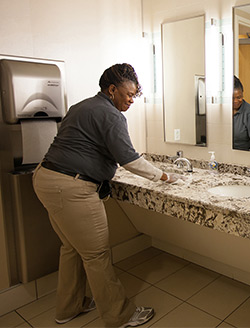It’s been proven that occupant/worker well-being and productivity is positively impacted by cleaner, healthier buildings. While this is excellent news, it’s easy to blur the lines between cleaning, sanitizing, and disinfecting — which means the best hygienic practices aren’t always implemented and germs can spread like wildfire.
All three work together in a broad sense to prevent infectious diseases, however they are distinctly different. Let’s break it down:
- CLEANING: this is the removal of germs, dirt, allergens, and microorganisms from objects or surfaces by physically using soap or detergent with water. While this process doesn’t necessarily kill germs, it removes them enough so that the risk of spreading infection is at least lessened. This option is best for low-risk surfaces, like floors, windows, or other places where the chances of pathogen transfer off the surface is low.
But even simple cleaning done regularly is enough to increase employee productivity. A study conducted by Jeffrey L. Campbell, Ph.D. and chair of facilities management at Brigham Young University, showed that 88% of the 1,481 people polled said that learning, productivity, or general well-being were hindered by being in environments that were dirty. Examples are dusty surfaces, fingerprints, or lingering cobwebs in corners. Cleaning will eradicate this, but remember, there will still be germs present.
- SANITIZING: this involves using an antimicrobial agent on objects, surfaces, and even living tissue, to reduce the number of disease-triggering organisms down to non-threatening levels. The most practical method of sanitizing hands, for instance, is to wash them with soap and hot water for a minimum of 20 seconds. Sanitization methods should be used for food-contact surfaces in order to adhere to health codes and regulations.
Other methods of sanitization could involve heat/steam, radiation, or chemicals like chlorine, iodine, or quaternary ammonium. In many cases, chemical sanitizers need to sit for an indicated “dwell time” for proper effectiveness.
- DISINFECTING: going a step further, disinfection involves the use of antimicrobial agents on non-living objects or surfaces to kill or deactivate microorganisms. Here’s where it can get tricky: disinfecting will kill germs on surfaces through chemicals, but it doesn’t always mean that dirt and impurities are actually being removed from the surface. Still, the risk of spreading infection is significantly lowered by simply destroying the microorganisms
This method is great for surfaces that are frequently touched, or likely to harbor pathogens on the regular. While they might not kill all bacteria, fungi, viruses, or spores, disinfecting has never been known for antiviral claims.
BEST PRACTICES
If you’re concerned about the safest and most heathy way to clean, your routine should include cleaning and disinfecting of surfaces or objects most often touched. This could include desks, keyboards, phones, countertops, doorknobs, faucets, trash can lids, elevator buttons or other panels/controls, hand rails, etc. Disinfecting wipes are great for electronic items like computers, keyboards, tablets, or phones. It’s important to make sure the wipes you are using won’t harm your electronics. The good news is, they make several kinds that will get the job done.
For surfaces that have been soiled with blood or bodily fluids, make sure to use gloves or other standard precautions before you begin the triple-threat of cleaning, sanitizing, and disinfecting. Remember that proper sanitization of an area often means the product has to stay on the surface for an allotted time frame — usually 3 to 5 minutes.
Sustainability is ever-evolving and has carved out a new trend that has created healthier environments in offices or other workplaces. By being proactive with healthy cleaning practices and knowing when each practice is best, you’ll play a vital role in improving overall air quality for the planet, and you’ll make a positive impact on the physical and mental wellbeing of your staff or coworkers.
